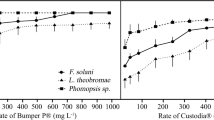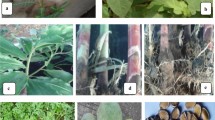Abstract
The pomegranate (Punica granatum L.), is one of the ancient and highly praised favorite fruit belong family Lythraceae of Myrtales order which is mainly grown in tropical and subtropical regions of the world. In recent years for there are many constraints for successful cultivation of pomegranate, among them, pest and diseases are the major ones. Common pathogens of pomegranate leaf and fruits include Alternaria fruit spot, Anthracnose and Cercospora leaf spot and these pathogens cause severe loss to pomegranate crop. Therefore, a field experiment was carried out to know the effect of Isopyrazam 12.5% + Difenoconazole 12.5% w/v (250 SC) against anthracnose, leaf spots and fruit rot of pomegranate during 2017–18 and 2018–2019 at College of Horticulture, Hiriyur. Experimental results revealed that all the treatments significantly reduced the leaf spots and fruit rot disease severity over untreated control. Amongst all the treatments in both season (2017–18 and 2018–19) Isopyrazam 12.5% + Difenoconazole 12.5% w/v (250 SC)@ 1 ml/liter was most effective in management of Alternaria fruit spot (3.1 and 2.4 PDI), anthracnose (3.8 and 3.2 PDI) and Cercospora leaf spot (3.6 and 3.65 PDI) respectively which was followed by the same fungicide @ 0.8 ml/lit, which was next best in the management of Alternaria fruit spot (3.4and 2.8 PDI), anthracnose (4.5 and 3.6 PDI) and Cercospora leaf spot (4.6 and 4.4 PDI) respectively when compared to the other treatments and high yield level of 11.0 kg/plant and 11.4 kg/plant was recorded in Isopyrazam 12.5% + Difenoconazole 12.5% w/v (250 SC) @ 1 ml/liter during 2017–18 and 2018–19 respectively.
Similar content being viewed by others
References
Ajigboye OO, Murchie E, Ray RV (2014) Foliar application of Isopyrazam and epoxiconazole improves photosystem II efficacy, biomass and yield in winter wheat. Pestic Biochem Physiol 114:52–60
Anonymous (2005) Area and production of pomegranate fruit. Dallimbavrutha Smaranika, pp 124–126
Anonymous (2017) http://www.horticulture.kar.nic.in. Accessed Mar 2018
Anonymous (2019a) http://www.cibrc.in. Accessed June 2020
Anonymous (2019b) http://www.frac.in. Accessed June 2020
Bartlett DW, Clough JM, Godwin JR, Hall AA, Hamer M, Parr-dobrzanski B (2002) The strobilurin fungicides. Pest Manag Sci 58:649–662
Beggren GT, Pinckard JA (1973) Movement of the systemic fungicide carboxin in to cotton seedlings assisted by the systemic insecticide monocrotophos. Plant Dis Rep 63:131–135
Bisht TS, Lakshmi R, Dinesh C, Naithani PRK, Ankit T (2019) Bio-efficacy evaluation of Chlorathalonil 40% w/w + Difenconazole 4% w/w SC against apple diseases. Int J Che Stu 8(1):398–405
Blandino M, Scarpino V, Giordano D, Sulyok M, Krska R, Vanara F, Reyneri A (2017) Impact of sowing time, hybrid and environmental condition of maize by emerging mycotoxins and fungal metabolites. Italian J Agron 12:928–935
De RK, Mandal RK (2007) Effect of seed treatment with fungicides on foot and stem rot disease caused by Phytophthora parasitica var. sabdariffae in Hibiscus sabdariffa. J Interacademicia 11:161–165
Dubos T, Pasquali M, Pogoda F, Casanova A, Hoffmann L, Beyer M (2013) Differentiate between the succinate dehydrogenase sequences of Isopyrazam sensitive Zymoseptoria tritici and insensitive Fusarium graminarium strains. Pestic Biochem Physiol 105:28–35
Edwards SG, Pirgozliev SR, Hare MC, Jenkinson P (2001) Quantification of trichothecene-producing Fusarium species in harvest grain by competitive PCR to determine the efficacy of fungicides against Fusarium head blight of winter wheat. Appl Environ Microbiol 67:1575–1580
Ekabote SD, Narayanaswamy P (2019) Bio-efficacy of various fungicides against Colletotrichum gloeosporioides causing anthracnose on pomegranate fruit. Acta Hortic 1254:253–256. https://doi.org/10.17660/ActaHortic.2019.1254.37
Ferreira EM, Alfenas AC, Maffia LA, Mafia RG (2006) Efficacy of systemic fungicides for control of Cylindrocladium candelabrum in eucalypt. Fitopatol Bras 31:468–475
Harp TL, Godwin JR, Scalliet G, Walter H, Stalker AD, Bartlett DW, Ranner DJ, Orson J, Bush M, Cook S (2011) Isopyrazam, a new generation cereal fungicide. Asp Appl Biol 106:113–120
Hirooka T, Miyagi Y, Araki F, Kunoh H (1989) Biological mode of action of flutolanil in its systemic control of rice sheath blight. Phytopathology 79:1091–1094
Holb IJ, Schnabel G (2007) Different effect of triazoles on mycelial growth and disease measurements of Monilinia fructicola isolates with reduced sensitivity to DMI fungicides. Crop Prot 26(753):759
Jamadar MM, Patil DR (2007) Bio-efficacy of new formulations against leaf/fruit spot on pomegranate. Karnataka J Agric Sci 20(4):865–866
Katia VX, Achala N, Gary EV (2019) Diseases of pomegranate (Punica granatum L.) in Florida. Univ. Florida, pp 349–353
Klittich CJ, Green FR, Ruiz JM, Weglarz T, Blackeslee BA (2008) Assement of fungicides systemicity in wheat using LC-MS/MS. Pest Manag Sci 64:1267–1277
Mckay AH, Hagerty GC, Follas GB, Moore MS, Christie MS, Beresford RM (2011) Succinate dehydrogenase inhibitor (SDHI) fungicides resistance prevention statergy. Newzeland J Plant Protec 64:119–124
Nithyameenakshi S, Jeyaramraja PR, Manian S (2006) Investigations on phytotoxicity of two new fungicides azoxystrobin and difenoconazole. Am J Plant Physiol 1:89–98
Prabhu NM, Subrata S (2018) Evaluation of fungicides against foot and stem rot and Phoma leaf spot of roselle and their impact on fibre yield. Indian Phytopathol. https://doi.org/10.1007/s42360-018-0094-z
Prasad RN, Bankar GJ, Vashishtha BB (1996) Problems and prospects of pomegranate cultivation in arid regions. Sym. On recent advances on management of arid ecosystem held at CAZRI, Jodhpur
Pruthviraj (2018) Studies on fungal fruit spot and fruit rot of pomegranate. M. Sc (Agri.) Thesis. Univ Agric Hortic Sci Shivamogga
Satler U, Harp T, Bartlett D, Gowin J (2010) Isopyrazam—a new drug for disease control in cereals. Julius-Kuhn-Archiv 428:90–91
Song Y, Zhang Z, Chen L, He L, Lu H, Ren Y, Mu W, Liu F (2016) Baseline sensitivity of Botrytis cinerea to the succinate dehydrogenase inhibitor Isopyrazam and efficacy of the fungicide. Plant Dis 100:1314–1320
Sundarraj N, Nagaraja S, Venkataramu MS, Jaganath MK (1974) Design and analysis of field experiments. Mysore
Thind TS, GoswamI S, Thind SK, Mohan C (2009) Resistance in Phytophthora parasitica against metalaxyl in citrus orchards. Indian Phytopathol 62(4):536–538
Walter PF (1997) Experimental design theory and application. 3rd Edition, New York
Wheeler BEJ (1969) An introduction to plant diseases. John Wiley and Sons Ltd., London, p 301
Author information
Authors and Affiliations
Corresponding author
Ethics declarations
Conflict of interest
On behalf of all authors, the corresponding author states that there is no conflict of interest.
Additional information
Publisher's Note
Springer Nature remains neutral with regard to jurisdictional claims in published maps and institutional affiliations.
Rights and permissions
About this article
Cite this article
Ekabote, S.D., Pruthviraj, Divyajyothi, U. et al. Efficacy of Isopyrazam 12.5% and Difenoconazole 12.5% w/v (250 SC) against Pomegranate diseases under field condition. Indian Phytopathology 74, 1045–1054 (2021). https://doi.org/10.1007/s42360-021-00415-2
Received:
Revised:
Accepted:
Published:
Issue Date:
DOI: https://doi.org/10.1007/s42360-021-00415-2




